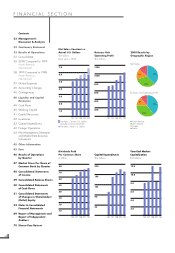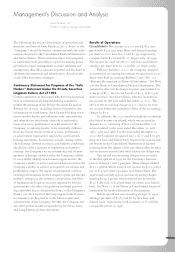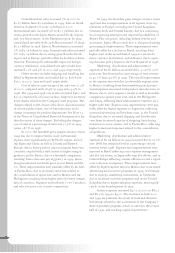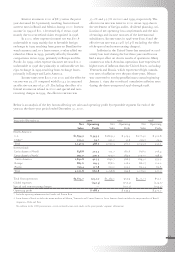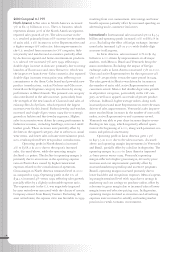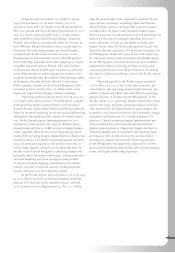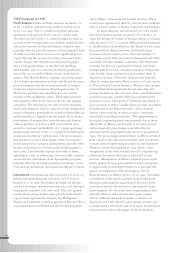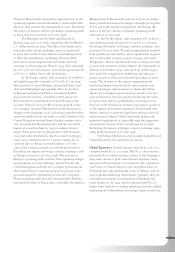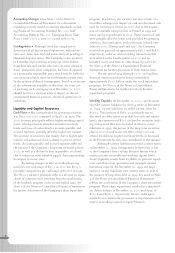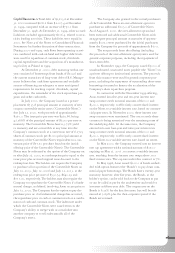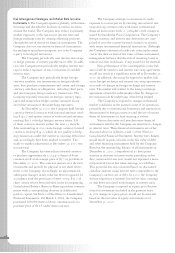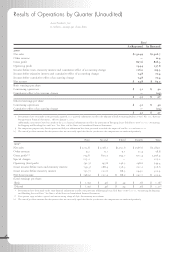Avon 2000 Annual Report Download - page 6
Download and view the complete annual report
Please find page 6 of the 2000 Avon annual report below. You can navigate through the pages in the report by either clicking on the pages listed below, or by using the keyword search tool below to find specific information within the annual report.
2000 Compared to 1999
North America > Net sales in North America increased
5% to $2.15 billion in 2000. The u.s. business, which
represents almost 90% of the North American segment,
reported sales growth of 5%. The sales increase in the
u.s. resulted primarily from a 6% increase in the number
of units sold, a 2% increase in active Representatives and
a higher average cft order size. Sales improvements in
the u.s. resulted from increases in cft categories, fash-
ion jewelry and watches and accessories, partially offset
by declines in apparel and home entertainment products.
u.s. sales of cft increased 7% over 1999 reflecting a
double-digit increase in skincare, primarily due to strong
launches of Botanisource and Anew Retroactive, which was
the largest cft launch ever. Color cosmetics also reported
double-digit increases versus prior year, reflecting our
commitment to the Avon Color brand and powerful new
product introductions, such as Nailwear and Glazewear.
Growth in the fragrance category was driven by strong
performance in Men’s brands. The personal care category
also contributed to the sales increase, particularly from
the strength of the new launch of Chamomile and sales of
existing Skin-So-Soft lines, which reported the largest
increases ever for this brand. Fashion jewelry and watches
increased mid-single digits versus 1999 due to strategic
growth in fashion and fine jewelry segments. Higher
sales in accessories were driven by strong performance in
fashion accessories, including handbags, totes and small
leather goods. These increases were partially offset by
declines in the apparel category, due to softness in casual
wear items, and lower sales in home entertainment prod-
ucts, resulting from fewer new product introductions.
Operating profit in North America increased
2% to $368.2 in 2000 due to the region’s increased
sales, discussed above, while the operating margin
declined 0.5 points. The decline in operating margin is
primarily due to an increase in the operating expense
ratio in Puerto Rico caused by higher transitional
expenses related to the consolidation of operations.
Gross margin in North America remained level in 2000
as compared to 1999. Operating profit in the u.s. of
$343.5 increased 4% versus 1999 reflecting sales growth,
partially offset by a slightly unfavorable expense ratio.
The expense ratio in the u.s. was negatively impacted
by asset writedowns associated with the closure of certain
Company-owned Avon Beauty Centers. Excluding the
asset writedowns, the expense ratio was favorable to 1999
resulting from cost containment, bpr savings and lower
benefit expenses partially offset by increased spending on
advertising and e-commerce initiatives.
International > International sales increased 9% to $3.53
billion and operating profit increased 11% to $662.8 in
2000. Excluding the effect of foreign exchange, interna-
tional sales increased 14% in 2000 with double-digit
increases in all regions.
In Latin America, sales increased 12% to $1.84
billion in 2000 driven by improvements in all major
markets, with Mexico, Brazil and Venezuela being the
main contributors. Excluding the impact of foreign
exchange, sales in Latin America increased 15% in 2000.
Units and active Representatives for the region rose 4%
and 10%, respectively, versus the same period in 1999.
The sales growth in Mexico was driven by increases in
the number of units sold, active Representatives and
customers served. Mexico had double-digit sales growth
in all product categories, particularly in the cft cate-
gory, as well as in apparel, as a result of greater product
selection. In Brazil, higher average orders, along with
increased prices and more Representatives were the main
drivers of sales improvements. Venezuela’s sales improve-
ment resulted from increases in the number of units sold,
orders, active Representatives and customers served.
Venezuela was able to post these increases despite severe
flooding in late 1999, which negatively affected opera-
tions at the beginning of 2000, along with persistent eco-
nomic and political uncertainty.
Operating profit in Latin America grew 13%
to $415.5 in 2000 due to the sales increases, discussed
above, and operating margin improvements in Venezuela
and Brazil, partially offset by a decline in Argentina. The
operating margin in 2000 in Latin America improved
20 basis points versus 1999. Venezuela’s operating
margin reflected a higher gross margin, driven by price
increases and cost improvement, partially offset by
increased marketing spending and incentive programs.
Brazil’s operating margin increased primarily due to
lower bad debt and recognition expenses. Mexico’s operat-
ing margin remained level with 1999 due to savings in
marketing and cost savings on purchase orders, offset by
a decrease in gross margin due to increased sales of lower
margin items and selective pricing cuts. In Argentina,
operating margin declined as incentives and advertising
expenses were increased to solidify our leading market
position in a weak economic environment.
36


